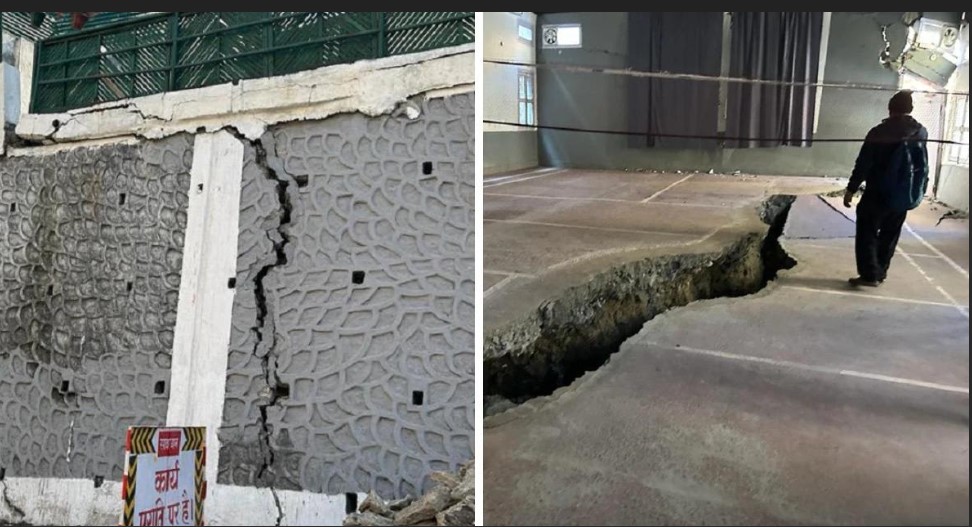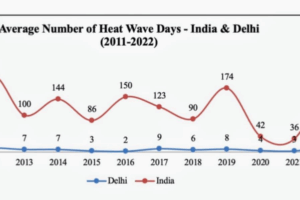Joshimath Disaster: An inevitable result of long neglect of scientific warnings, of
gross financialization of nature and total lack of Environmental and Social
Safeguard Policies!
Joshimath woke up to large cracks on roads and houses with muddy water seeping
from them, not in one or two but in over 600 houses! News media and portals are now
calling it the ‘sinking’ town’! Relief and evacuation operations have started but
proceeding at snail’s pace, with hundreds of families forced to spend near-zero temp
nights under flimsy shelters. In its usual casual manner, the bjp chief minister of
Uttarakhand has talked about constituting yet another “committee to investigate”,
despite the fact that the underlying causes are well known for about 50 years now, with
recommendations and warnings by earlier expert committees violated with impunity!
This historical place that is the gateway to Badrinath and Hemkund Sahib was long
known to be a land subsidence zone by experts! There are 4-5 primary reasons why it is
so, but the govt and its agencies – “chardham mahamarg vikas pariyojana” and NTPC —
criminally neglected to act upon expert advice. Today’s disaster is a direct result of
that.
1. Joshimath town sits on the loose debris of a century old landslide. This itself should
have been reason enough not to permit massive construction and infrastructure projects
here.
2. The region falls in seismic zone-V, or the highest risk of earthquakes. a number of
small and medium earthquakes happened in the vicinity, plus the major chamoli
earthquake of 1999 (6.6–6.8 in richter scale) shook up the already unstable base of the
town.
3. The area is undercut by several fast flowing mountain rivers like the Dhauliganga,
rishiganga, Alaknanda and others. Increasing heavy rainfalls and flash floods, made
worse by erratic climate (recent Dhauliganga disaster is just an example) are fast
eroding the “toe region” of these hills, leading to greater instability and possibility of
slides for the overlying soil – taking all the structures along .
4. Gross commercialization of the fragile Himalayas for both “religious and nature
tourism”, without any consideration of ‘carrying capacities’ was encouraged and
massive construction in the town was allowed in the name of economic growth, with
large and heavy hotels and other construction booming.
5. Total failure of responsible governance & accountability of investment – in spite of all
these being common knowledge for about 50 years now. Major land destabilizing
infrastructure projects like the “char dham all weather road”, the “Vishnugad
Hydroelectric project” etc were given environmental clearance and carried out with total
disregard to safety, accelerating the disaster.
The 1976 “Mishra Commission”, with experts from specialized agencies and constituted
by the then government, made very clear observations about most of these
vulnerabilities. It clearly warned against heavy construction activities, removing base
boulders, disturbing the underlying soil etc. Yet, those ‘prohibited’ activities are exactly
those that both NTPC and ‘chardham road’ violated. Thus they are directly responsible
for the current disaster, along with successive governments of Uttarakhand and the
centre.
Investments in unsustainable Hydel Power Projects is a cause for major concern
in the fragile Himalayan ecology
While Joshimath is in the news cycle right now, it is by no means an aberration. To
throw caution to wind at the altar of development and growth has in fact become the
norm. The fragile topography of the Himalayas from Himachal to Sikkim bears the risks
of such mindless play of dice. One of the causal factors that stand out for such a
disaster, even the government’s own experts agree, is the Tapovan – Vishnugarh
HydroElectric Power Project located below the major city!
While a lot is being talked about today in terms of emergency measures, rehabilitation
and demolition, not much is being said about how this came about? Or more importantly
how did such rampant construction get the requisite clearances? Or who in fact is
funding such projects? Where is the money coming from?
Construction started at the Hydroelectric Power Project in 2006 with an estimated cost
of Rs. 29,785 Million (USD 677 Million) was scheduled to be commissioned in 2012 –
13. After the destruction of the 2013 and 2021 floods washing away the constructions,
the project was scheduled to be commissioned this year! The project has already been
delayed and carries a Rs. 1500 crore loss due to the delays! Despite being in a highly
seismic and ecologically fragile Himalayan area the project got Environment and Forest
clearances in 2004 and the Environment Impact Assessment (EIA). The money came
from the Asian Development Bank.
The EIA report submitted by NTPC to Asian Development Bank mentions Uttarakhand
is a seismically active state classed under seismic zones IV and V on the Seismic
Zoning Map of India Its assessment of impacts focuses on four major components –
hydrology that focuses only on the reduced river flow between barrage, aquatic
ecosystems focusing on prevention of upstream fish movement, land resources on the
loss of agricultural and forest land and the resettlement of 57 households. Even though
the EIA claims to have done a detailed assessment of the land, soil and impacts, it does
not take into account the impact of the construction process on the geology and ecology
of the place. Particularly since it is a landslide prone area. Even after the constructions
were washed away in the 2013 and 2021 floods, the project was not stalled or stopped
but continued construction once again! Nor does it take into account the now prophetic
directions of the Mishra Committee.The EIA in fact justifies the project on the ground of
its contribution to growth and the need for clean energy while giving a blind eye to it’s
not so clean consequences.
Need for robust Environmental and social safeguards in development finance
The fact that such unviable and unsustainable projects get clearance goes on to show
the problems around implementation even as some of these multinational development
banks like the ADB claim to have environmental and social safeguards in place. What it
also shows is the sorry state of affairs when it comes to our own banks that have no
such safeguards in place when it comes to development lending.
A slew of Indian Financial institutions have their fingers in the pie! NTPC has raised
hundreds of crores through issue of bonds by showing the Tapovan – Vishnugarh
project as one of the ‘securities’. LIC, Central Bank of India, Punjab National Bank,
Union Bank of India, Indian Overseas Bank are some of the institutional lenders to
these bonds. This is not just with this one project, as of March 2017, long-term loan
borrowing of NHPC stood at Rs. 17,246 crores which includes secured loans. The
secured loans include borrowings from domestic banks and financial institutions like
State Bank of India, Indian Overseas Bank, ICICI Bank Limited, Jammu & Kashmir
Bank Limited, Bank of India, Axis Bank, State Bank of Patiala, State Bank of Bikaner &
Jaipur, HDFC Bank, IndusInd Bank, Bank of Baroda, Central Bank of India, Kotak
Mahindra Bank, RBL Bank, Life Insurance Corporation, Power Finance Corporation,
and Rural Electrification Corporation. Not a single one of these institutions have an
environment and safeguard policy with accountability mechanisms!
Such disasters are rude reminders of the mindless model of development that is being
forced down on us financed by our own institutions!
We the undersigned demand:
1. Immediate stalling of the Tapovan – Vishnugad hydro project
2. A review and reduction of all major destructive projects in the Himalayan region
3. Need for environment and social safeguards policy for indian financial institution
Joshimath Disaster: An inevitable result of long neglect of scientific warnings, of gross financialization of nature and total lack of Environmental and Social Safeguard Policies!


















